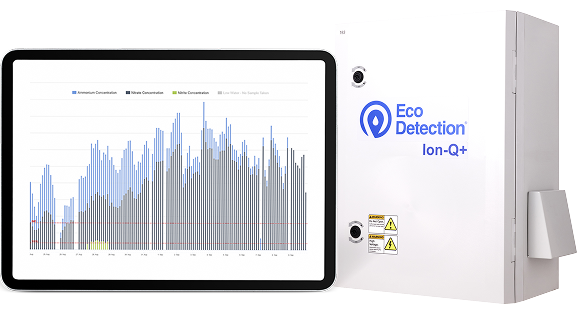Eco Detection’s Ion-Q+ technology is a cutting-edge, cost-effective and highly efficient solution for wastewater treatment plants looking to:
- Gain real-time, comprehensive water quality data and insights
- Provide real-time nutrient discharge alerts to ensure environmental compliance
- Protect local ecosystems from harmful discharges
- Reconcile effluent discharge data with variable WTTP operations across the day

The Challenges
Water utilities are facing a growing challenge: servicing an expanding population with ageing infrastructure while continuing to reduce their environmental impact.
Wastewater Treatment Plants (WWTPs) discharge Nitrogen and Phosphorous into waterways under a license granted by local Environmental Protection Authorities (EPA). However, exceeding these discharge limits can result in significant penalties, as well as environmental harm.
Under the General Environment Duty (GED), businesses are required to understand and manage the risks they pose to the environment. This includes maintaining a clear ‘State of Knowledge’ about any potential risks.
As the population grows, the demands placed on WWTPs continue to increase, and many older plants struggle to cope. Additionally, climate change contributes to higher sewer system Infiltration and Inflow (I&I), which leads to surges in influent and exacerbates these challenges.
However, traditional methods, such as manual grab sampling and laboratory analysis are increasingly impractical due to resource constraints, delay in obtaining data for immediate reconciliation of daily operations and the high costs associated with frequent sampling.
The Solution
Eco Detection’s Ion-Q+ provides frequent, real-time in-situ monitoring for WWTP operators, enabling immediate actions to control the risks of exceeding discharge license limits.
With Ion-Q+, monitoring of dissolved inorganic ammonium, nitrate and nitrite for Total Inorganic Nitrogen (TIN) and Dissolved Reactive Phosphorous (DRP) or orthophosphate is now possible. Sampling at both upstream and downstream of the WWTP discharge point provides critical data in real-time. This data can be seamlessly integrated into plant Supervisory Control and Data Acquisition (SCADA) systems for immediate analysis and action if necessary.
Long term, Ion-Q+ offers a significantly lower-cost solution compared to traditional manual sampling methods, with the added benefit of more frequent, enriched discharge data.
This not only helps utilities meet regulatory requirements but also provides a deeper understanding of the plant’s operational risks and their potential environmental impact.
The Benefits
Real-time monitoring
Provides frequent, in-situ monitoring of TN and TP levels, enabling immediate corrective actions.
Improved efficiency
Eliminates the need for manual sampling, allowing more frequent monitoring without additional strain on resources.
Cost-effective
Significantly lowers the total cost of effluent operations data compared to manual grab sampling and laboratory analysis.
Supports sustainability
Enables water utilities to manage growing populations and ageing infrastructure while minimising environmental impact.
Enhanced compliance
Helps ensure discharge limits are consistently met, reducing the risk of penalties from regulatory authorities.
Environmental protection
Reduces the risk of harmful downstream discharges, helping prevent eutrophication and algal blooms.
Seamless integration
Data is fed directly into plant SCADA systems for quick decision-making and automated actions.
Increased operational knowledge
Enhances the “State of Knowledge” for WWTPs, providing necessary risk management oversight of the operations.